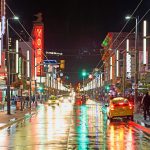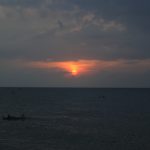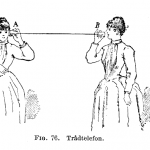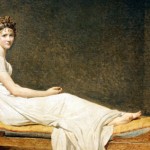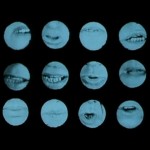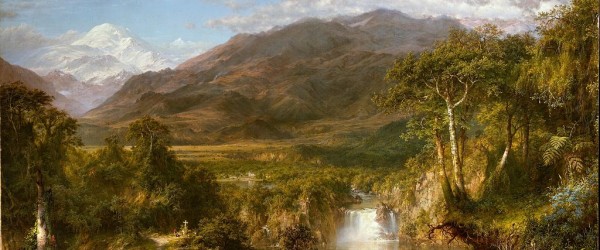
Landscape Art and Frederic Edwin Church
Art, Commentary, Culture, Essays“One generation abandons the enterprise of another like stranded vessels.”- Henry David Thoreau, Walden
Landscape art can be elusive. Within the sort of art exhibition that aggregates paintings from a variety of genres, those with the subjects of clouds, mountains, trees, forests, river, ocean etc. are very likely the least interesting ones for the most ignorant of gallery-goers, who might, however, still take notice of the vivid colours and the superb brushworks before hastening on towards the more popular showstoppers. Colours and brushworks- the only attributes those viewers can recall of the paintings that quickly become no more than a passing memory, almost negligible in their perceived role of acting as a foil to the more notable masterpieces.
Our instinctive apathy towards landscape painting might be partly ascribed to the general ignorance of Nature. History testifies to how precious little do we know of the natural environment we’re inhabiting, how frequently such wanting of knowledge abets the selfish ones to gratify their avarice at the expense of the harmony amidst all living souls. Modern civilisation destroys totally the tenuous bond we still share with our Mother Nature. There is hardly a plot of land extant on earth that is not smeared with the footprints of mankind. The nature we know now is far removed from the paradisiac kingdom of yore- the purity is irrevocably corrupted, the beauty ruthlessly tainted.
Possession comes in various forms. Photography, in many ways, proffers an advisable means of possessing nature whilst leaving it intact and unharmed. Viewing for the first time a framed photograph of Mount Everest must be one of peculiar excitement. People are no longer obliged to go through an extremely hazardous, toiling journey on the sole purpose of snatching a glimpse of the mountain’s magnificent presence. They can now enjoy the beautiful spectacle in an exhibition hall, or even in their drawing room. The incontestable verisimilitude between Mount Everest and that in a well-produced photograph- though, of course, the mountain here is considerably smaller in scale- gives the ownership of the artwork an undertone of meaning not dissimilar to the possessiveness of a greedy entrepreneur. Moreover, by imprisoning the mountain with his camera the photographer guarantees its immortality. Such possessiveness thus smells faintly of narcissism.
The advent of photography, regardless of how it is possibly the only art form that successfully blurs the boundary between art and reality, undermines somewhat the novelty and innocence that are inherent in its more archaic counterparts. In regard to the portrayals of nature especially, photography is no match for painting.
My hitherto ignorance for landscape painting was to change when I first alighted on the paintings of Frederic Edwin Church. As a pupil of the renowned American landscape painter Thomas Cole, Church became one of the leading figures of the Hudson River School, a mid-19th century art movement founded by Cole, whose portrayals of American wilderness were profoundly influenced by the idealised vision of Romantic landscape art. Like many landscape painters of his contemporary and the succeeding generation, Cole had a penchant for the synthesis of nature and allegory. Church diverged from his teacher by giving the allegorical themes a wide berth and restricting his entire oeuvre to the depictions of nature. This decisive break from the norm was arguably one of the reasons Church was criticised for lacking an imaginative and spiritual flair in his handling of the subject.
But is the aforesaid a justifiable verdict of Church’s paintings? There is an unwritten law for every novice reader of landscape painting to always delve into the tiniest detail and facts, regardless of how inconsequential they might be comparing to the whole. In The Heart of the Andes (1859) it is the little grave on the lower left of the painting. Not much effort will be needed in ferreting out this tiny feature as the sun kindles the grave to a gentle, noticeable glow. In the vicinity of the grave is a small waterfall which is almost transmuted into a cloud of white fume as it plunges into the water. The water is so emphatically rendered that we can virtually hear its deafening roar. Our eyes then skim through the birch trees, the rocky plains, the mighty mountains, and the snow-capped mountains in the far distance. Who said Church’s art was bland and unspiritual? Unlike any typical landscape painting, the pivot of Church’s is neither the mountains nor the trees nor the plains. Rather, it is that little grave- a gem embedded within the hovering nature, a lull against the excited hubbub. These harmonious juxtapositions of contrasts stimulate the painting to life.

Nature can have its dramatic moments. Church made sure he always had the dark palette ready when he encountered one of Nature’s shrewish tempers. The volcanic eruption is always an apt subject for the landscape painters to demonstrate their proficiency in tackling a more theatrical theme with a more monumental scale. English painter John Martin recognised a correlation between volcanoes and the stories in Revelation. His many depictions of the erupting volcanoes are to be seen as a retelling of the Revelation tales set in a growingly industralised England, which is swamped by the boiling magma of human destructions. Whilst Martin’s vision was bleak and unrelenting, Church could not seem to rid himself off the Romantic influence that is implicit in a majority of his works. In Cotopaxi (1862) the spectacle of a volcanic eruption has the same beauty as a flaming sunset. Curiously, a sun can be perceived dwelling upon the horizon, distinguishing itself out of an expanding throng of black smoke. In common with the little grave in Heart of Andes, Church was wont to create a pleasing sense of quietude amidst the chaos. I see the painting not so much a bravura of unmitigated horror as that of Martin’s. Instead, I see the fluid brushwork, the soft nuances of colours, the brilliant interplay of light and shade, and the hint of a possible hope glimmering amidst utter despair.

Church’s laudable effort in preserving the purity of nature did not, however, make his landscape paintings any less elusive. There are, within his sprawling oeuvre, works that one knows not how to make of, but can only admire the more obvious features like forms and colours. Scene in the Blue Mountains, Jamaica (1865) belongs to this sort of paintings. One struggles to no avail in grasping at a more precise and critical appraisal of the painting without yielding to a merry-go-around of banal enumeration of facts like the dangerously steep mountain ridges, a wide spectrum of green from yellow-green to forest-green, the ingenious lighting effect that helps create the distance-diminished detail.

Landscape paintings are an acquired taste but their importance is by no means any inferior to those of other subjects. Their elusiveness is the very incentive that spurs us on to keep looking.







